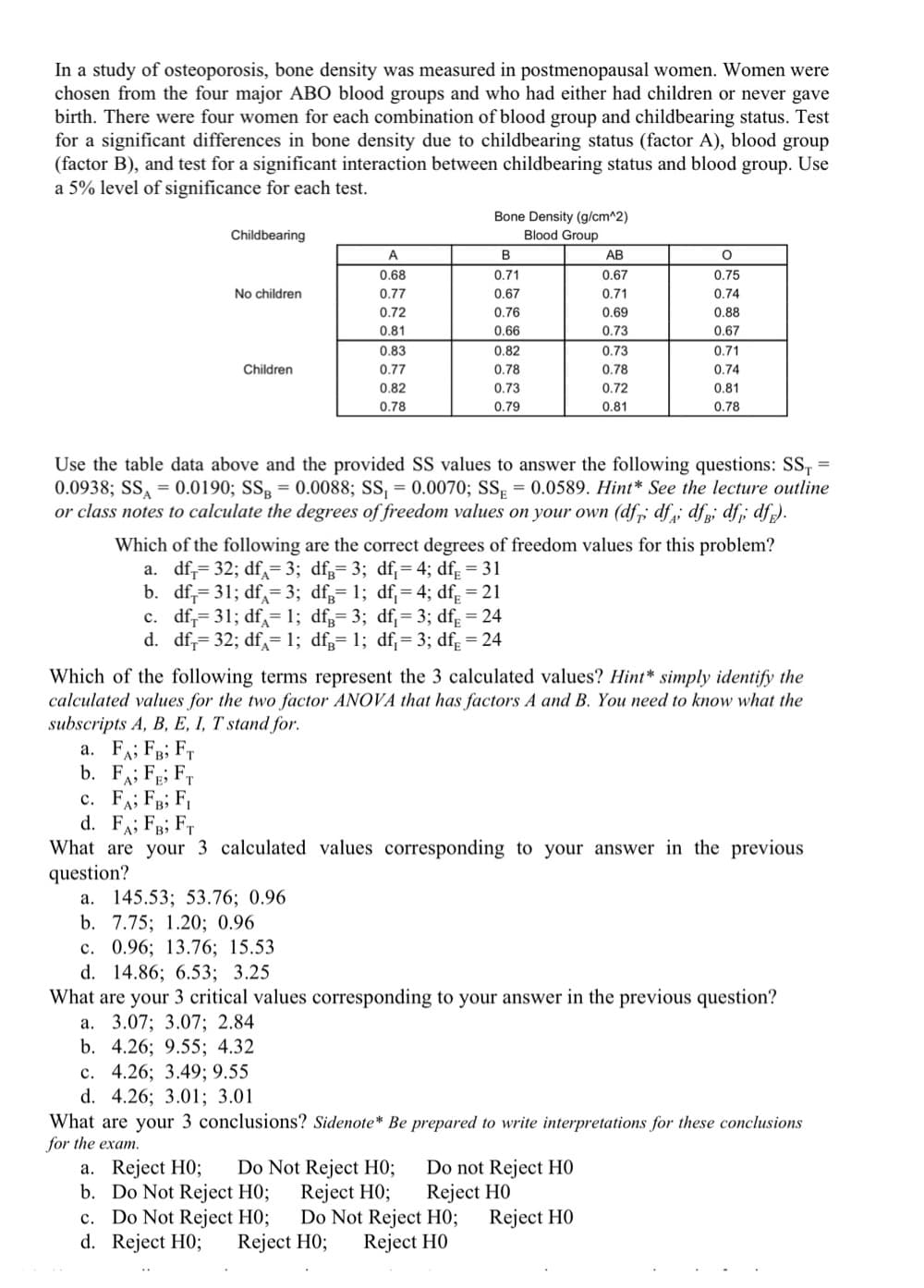In a study of osteoporosis, bone density was measured in postmenopausal women. Women were chosen from the four major ABO blood groups and who had either had children or never gave birth. There were four women for each combination of blood group and childbearing status. Test for a significant differences in bone density due to childbearing status (factor A), blood group (factor B), and test for a significant interaction between childbearing status and blood group. Use a 5% level of significance for each test. Bone Density (g/cm^2) Childbearing Blood Group A В АВ 0.68 0.71 0.67 0.75 No children 0.77 0.67 0.71 0.74 0.72 0.76 0.69 0.88 0.81 0.66 0.73 0.67 0.83 0.82 0.73 0.71 Children 0.77 0.78 0.78 0.74 0.82 0.73 0.72 0.81 0.78 0.79 0.81 0.78 Use the table data above and the provided SS values to answer the following questions: SS, = 0.0938; SS, = 0.0190; SS, = 0.0088; SS, = 0.0070; SSg = 0.0589. Hint* See the lecture outline or class notes to calculate the degrees of freedom values on your own (df; df dfg; df; df). %3D Which of the following are the correct degrees of freedom values for this problem? a. df,= 32; df,= 3; df;= 3; df;= 4; df; = 31 b. df,= 31; df,= 3; df= 1; df,= 4; dfp = 21 c. df,= 31; df,= 1; df= 3; df;= 3; df = 24 d. df,= 32; df,= 1; df;= 1; df;= 3; df = 24 Which of the following terms represent the 3 calculated values? Hint* simply identify the calculated values for the two factor ANOVA that has factors A and B. You need to know what the subscripts A, B, E, I, T stand for. a. FA; FB; Fr b. FA; FE; Fr c. FA; Fp; F, d. FA; FB; FT What are your 3 calculated values corresponding to your answer in the previous question? а. 145.53; 53.76; 0.96 b. 7.75; 1.20%; 0.96 c. 0.96; 13.76; 15.53 d. 14.86; 6.53; 3.25
Unitary Method
The word “unitary” comes from the word “unit”, which means a single and complete entity. In this method, we find the value of a unit product from the given number of products, and then we solve for the other number of products.
Speed, Time, and Distance
Imagine you and 3 of your friends are planning to go to the playground at 6 in the evening. Your house is one mile away from the playground and one of your friends named Jim must start at 5 pm to reach the playground by walk. The other two friends are 3 miles away.
Profit and Loss
The amount earned or lost on the sale of one or more items is referred to as the profit or loss on that item.
Units and Measurements
Measurements and comparisons are the foundation of science and engineering. We, therefore, need rules that tell us how things are measured and compared. For these measurements and comparisons, we perform certain experiments, and we will need the experiments to set up the devices.
Need some help with calc

Trending now
This is a popular solution!
Step by step
Solved in 2 steps









